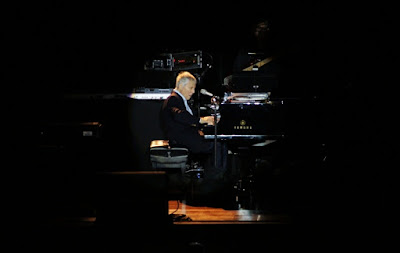
The biggest issue in Canberra politics these days is the tram (for those anti) / light rail (for those pro). For this post, I will use lr, at least for now... I have an opinion, but I also have friends with differing opinions, so I decided to test myself by attending an open seminar session on the case for Canberra's light rail convened by the University of Canberra's Institute for Governance an Policy Analysis and chaired by ex-Chief Minister Jon Stanhope. Stanhope was academically neutral, although I read in recent days in the paper that previous plans for light rail in his time had not stacked up. This seminar brought together UCan urban planner Barbara Norman (pro) and economist David Hughes (anti). They are both relevantly knowledgeable, having both held highly relevant senior positions in Canberra's local public service (ACT planning and major project analysis at ACT Treasury). Barbara spoke first, arguing for resilience, integrated "multimodal transport", "doing nothing is not an option", expected growth, "excellent opportunities for innovation" (innovation, in trams?), climate change, healthy cities, social justice, while admitting she is "not an expert on cost/benefit". David argued that lr was a "poor project" with low cost/benefit (0.5) on key measures, low carbon savings ($13m), which "doesn't do much" / "impact is negligible", that core benefits (including transport, health, congestion and environment) are just 40% of total benefits, while 60% is other questionable benefits (the same balance for Sydney's lr is 95%-5%), and that risks are on "just about everything" (budget, disruption, private involvement, patronage, future of planning and technologies).

Questions were primarily themed anti. The first doubted the cost. Barbara responded that "stars aligned" in terms of PM, ACT government, a prepared industry (I might add interest rates). David observed history of government project cost overruns, the enormity (esp of the full plan) against the ACT budget, especially given the Gunghalin line is the easiest to justify. Then climate change, town centre planning in Canberra, experiences with other cities (David argues experience is poor, claiming to use the Government's own numbers and examples - Gold Coast, Perth, Portland, etc; Barbara argues for), Barbara mentioned recent articles in the Canberra Times, including Ross Gittins in support of public transport (but ignored an editorial, perhaps the same day, on dangers of the project), "religious conversions" of tram supporters, input from Gen X/Y (David interestingly noted that Braddon has largely developed without government involvement), implications for transport and other costs and government secrecy, comparisons with Melbourne and the argument over health and activity (I hear the tram will only have 3 stops on Northbourne Ave, so walking is not optional), social equity, pleasantness of tram travel, contracts. The audience responses were sometimes one-sided. Most questions were reasonable and reasoned, although some were of the "I liked using trams on holiday in Europe" variety.
So my summation? I am very concerned about climate change and interested in city development, but I call this a tram. It seems to do little new, have numerous problems (infrequent stops, no ability for passing), will cost lots and divert government monies, is not supported by infrastructure or economic experts, is inflexible (isn't the recent tunnel problem an argument against such an inflexible system?) ... there's more but I can't be bothered writing it all here. It's certainly enough to have me writing letters to Rattenbury, Corbell and Barr. As for the arguments, I found David's detailed and evidence-rich but Barbara's vague and wishful. As I see it, this is a lose-lose situation for this centre-left voting public: Labor/Greens win next year's election and we have an expensive project of little real benefit that that will constrain good spending, or Libs win and cancel lr with significant cost in monies and trashed reputation and readiness to explore future public transport options. So, why death wish? It's the expression used by a guy I sat next to and talked with. He'd been chummy with Stanhope before the meeting and obviously moved in those circles. As he said, and I've been recently thinking, governments reach a used-by date; this looks like Labor's death wish. I reckon he might be right.
Jon Stanhope chaired a session on Canberra light rail under the auspices of the University of Canberra's Institute for Governance an Policy Analysis. UCan urban planner Barbara Norman and economist David Hughes spoke for and against the tram.
Lecture website with recommended reading
































